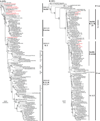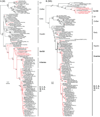The development and genetic diversity of H5N1 influenza virus in China, 1996-2006
- PMID: 18774155
- PMCID: PMC2651962
- DOI: 10.1016/j.virol.2008.07.038
The development and genetic diversity of H5N1 influenza virus in China, 1996-2006
Abstract
Since it was first detected in 1996, the Goose/Guangdong/1/1996 (Gs/GD) H5N1 influenza virus and its reassortants have spread to over 60 countries, with over 20 distinct genetic reassortants previously recognized. However, systematic analysis of their interrelationship and the development of genetic diversity have not been explored. As each of those reassortants was first detected in China, here 318 full-length H5N1 virus genomes isolated from 1996 to 2006 in this region were phylogenetically analyzed. Our findings revealed two major group reassortment events in 2001 and 2002 that were responsible for the generation of the majority of the 44 distinct Gs/GD genotypes identified, excepting those 1997 variants. Genotype replacement and emergence occurred continually, with 34 transient genotypes detected while only 10 variants were persistent. Two major replacements of predominant genotypes were also observed: genotype B replaced by Z in 2002 and then genotype Z replaced by the now predominant genotype V in 2005.
Figures






References
-
- Alexander DJ. An overview of the epidemiology of avian influenza. Vaccine. 2007;25:5637–5644. - PubMed
Publication types
MeSH terms
Substances
Associated data
- GDB/CY030878
- GDB/CY030879
- GDB/CY030880
- GDB/CY030881
- GDB/CY030882
- GDB/CY030883
- GDB/CY030884
- GDB/CY030885
- GDB/CY030886
- GDB/CY030887
- GDB/CY030888
- GDB/CY030889
- GDB/CY030890
- GDB/CY030891
- GDB/CY030892
- GDB/CY030893
- GDB/CY030894
- GDB/CY030895
- GDB/CY030896
- GDB/CY030897
- GDB/CY030898
- GDB/CY030899
- GDB/CY030900
- GDB/CY030901
- GDB/CY030902
- GDB/CY030903
- GDB/CY030904
- GDB/CY030905
- GDB/CY030906
- GDB/CY030907
- GDB/CY030908
- GDB/CY030909
- GDB/CY030910
- GDB/CY030911
- GDB/CY030912
- GDB/CY030913
- GDB/CY030914
- GDB/CY030915
- GDB/CY030916
- GDB/CY030917
- GDB/CY030918
- GDB/CY030919
- GDB/CY030920
- GDB/CY030921
- GDB/CY030922
- GDB/CY030923
- GDB/CY030924
- GDB/CY030925
- GDB/CY030926
- GDB/CY030927
- GDB/CY030928
- GDB/CY030929
- GDB/CY030930
- GDB/CY030931
- GDB/CY030932
- GDB/CY030933
- GDB/CY030934
- GDB/CY030935
- GDB/CY030936
- GDB/CY030937
- GDB/CY030938
- GDB/CY030939
- GDB/CY030940
- GDB/CY030941
- GDB/CY030942
- GDB/CY030943
- GDB/CY030944
- GDB/CY030945
- GDB/CY030946
- GDB/CY030947
- GDB/CY030948
- GDB/CY030949
- GDB/CY030950
- GDB/CY030951
- GDB/CY030952
- GDB/CY030953
- GDB/CY030954
- GDB/CY030955
- GDB/CY030956
- GDB/CY030957
- GDB/CY030958
- GDB/CY030959
- GDB/CY030960
- GDB/CY030961
- GDB/CY030962
- GDB/CY030963
- GDB/CY030964
- GDB/CY030965
- GDB/CY030966
- GDB/CY030967
- GDB/CY030968
- GDB/CY030969
- GDB/CY030970
- GDB/CY030971
- GDB/CY030972
- GDB/CY030973
- GDB/CY030974
- GDB/CY030975
- GDB/CY030976
- GDB/CY030977
- GDB/CY030978
- GDB/CY030979
- GDB/CY030980
- GDB/CY030981
- GDB/CY030982
- GDB/CY030983
- GDB/CY030984
- GDB/CY030985
- GDB/CY030986
- GDB/CY030987
- GDB/CY030988
- GDB/CY030989
- GDB/CY030990
- GDB/CY030991
- GDB/CY030992
- GDB/CY030993
- GDB/CY030994
- GDB/CY030995
- GDB/CY030996
- GDB/CY030997
- GDB/CY030998
- GDB/CY030999
- GDB/CY031000
- GDB/CY031001
- GDB/CY031002
- GDB/CY031003
- GDB/CY031004
- GDB/CY031005
- GDB/CY031006
Grants and funding
LinkOut - more resources
Full Text Sources
Other Literature Sources
Medical
Research Materials

